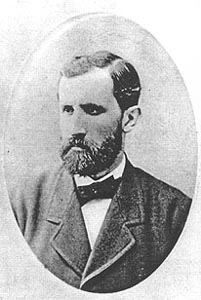|

|
| |
|
 |
|
Friedrich Miescher |
|
*13.8.1844 †26.8.1895
in Tübingen 1868-1870 |
| |
|
| |
|
| |
|
| |
|
| |
|
| |
|
|
|
|
back to History
|
|
|
|
|
 Friedrich
Miescher (13 August 1844, Basel - 26 August 1895, Davos) was a
Swiss biologist. He isolated various phosphate-rich chemicals,
which he called nuclein (now nucleic acids), from the nuclei of
white blood cells in 1869 at Felix Hoppe-Seyler's laboratory at
the University of Tübingen, Germany, paving the way for the
identification of DNA as the carrier of inheritance. The
significance of the discovery, first published in 1871, was not at
first apparent, and it was Albrecht Karl Ludwig Martin Leonard
Kossel who made the initial inquiries into its chemical structure. Friedrich
Miescher (13 August 1844, Basel - 26 August 1895, Davos) was a
Swiss biologist. He isolated various phosphate-rich chemicals,
which he called nuclein (now nucleic acids), from the nuclei of
white blood cells in 1869 at Felix Hoppe-Seyler's laboratory at
the University of Tübingen, Germany, paving the way for the
identification of DNA as the carrier of inheritance. The
significance of the discovery, first published in 1871, was not at
first apparent, and it was Albrecht Karl Ludwig Martin Leonard
Kossel who made the initial inquiries into its chemical structure.
Miescher came from a scientific family: his father and his uncle
held the chair of anatomy at the University of Basel. As a boy he
was shy but intelligent. He had a partial hearing impairment due
to a severe attack of typhus. But this did not stop him from
having an interest in music and his father performed publicly.
Miescher himself studied medicine at Basel. In the summer of 1865
Friedrich worked for the organic chemist
Adolf Stecker
in Goettingen. His studies were interrupted for the year when he
became ill with typhoid fever; however, he still received his M.D.
in 1868.
Miescher felt that his partial deafness would be a disadvantage as
a doctor so he turned to physiological chemistry. Miescher
originally wanted to study lymphocytes but was encouraged by Felix
Hoppe-Seyler to study leucocytes. Miescher was interested in
studying the chemistry of the nucleus. Lymphocytes were difficult
to obtain in sufficient enough numbers to study while leucocytes
were known to be the one of the main components in pus and could
be obtained from bandages at the nearby hospital. The problem was,
however, washing the cells off the bandages without damaging them.
Miescher devised different salt solutions eventually producing one
with sodium sulphate. The cells were filtered. Since centrifuges
were not present at this time the cells were allowed to settle at
the bottom of a beaker. He then tried to isolate the nuclei free
of cytoplasm. He subjected the purified nuclei to an alkaline
extraction followed by acidification resulting in a precipitate
being formed which Miescher called nuclein (now known as DNA). He
found that this contained phosphorus, nitrogen, and sulfur. The
discovery was so unlike anything else at the time that Hoppe-Seyler
repeated all Miescher's research himself before publishing it in
his journal. Friedrich then went on to study physiology at Leipzig
in the laboratory of Carl Ludwig for a year before returning to
Basel where he was appointed professor of physiology.
Miescher and his students researched much of the nucleic acid
chemistry but their function remained unknown. However, his
discovery played an important part in the identification of
nucleic acids as the carriers of inheritance. The importance of
Miescher's discovery was not apparent until Albrecht Karl Ludwig
Martin Leonard Kossel a German physiologist specializing in the
physiological chemistry of the cell and its nucleus and of
proteins carried out research on the chemical structure of nuclein.
Friedrich Miescher is also known for demonstrating that carbon
dioxide concentrations in blood regulate breathing.
He died of tuberculosis in 1895 aged 51. He has had a laboratory
of the Max Planck Society in Tübingen and a research institute in
Basel named after him.
|
|
|
|
![]()